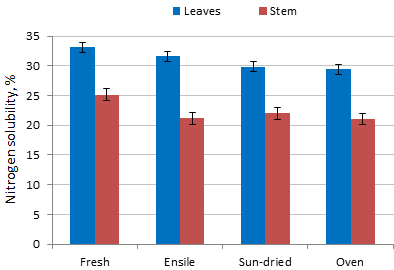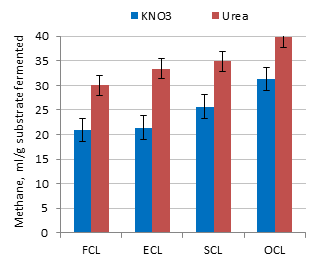 |
 |
| Figure 1. Nitrogen solubility in the cassava foliage | Figure 2. Effect of cassava leaves on methane produced per unit substrate fermented |
|
Reducing Greenhouse Gas Emissions from Livestock and Soils |
The aim of this study was including two experiments with these objectives is to determine the nitrogen solubility of cassava foliage and to study effect of nitrogen solubility from cassava leaves meal as source of protein on methane production using NPN source as potassium nitrate or urea with substrate of cassava root meal in an in vitro incubation system.
Experiment 1: The treatments a completely randomized design with 2*4 factorial arrangements with four replications of the following treatments were: source of position as leaves and stem, source of processes as fresh, ensile, sun-dried and oven-dried. N solubility was decreased by ensiling and with severity of drying (Figure 1).
Experiment 2: An in vitro incubation system was used to evaluate the following treatments in a completely randomized design with 2*4 factorial arrangements with four replications of the following treatments: source of NPN as urea or potassium nitrate; source of cassava leaves as fresh, ensiled, sun-dried and oven-dried. All treatments had cassava root meal as substrate. The quantity of substrate was 12g to which were added 240 ml rumen fluids (from slaughtered buffalo) and 960 ml of buffer solution. The incubation was for 24h with measurements of total gas production, percent methane at intervals of 12 and 24 hours and determination of residual unfermented substrate at the end of 12 and 24h. The gas production and methane percentage in the gas were increased with incubation time. The percentage of methane in the gas was reduced when nitrate replaced urea as the NPN source and in fresh cassava leaves less than dried cassava leaves at all stages of the fermentation. Methane produced per unit of fermented DM was decreased by nitrate compared with urea and was inversely related to N solubility.
Key words: Climate change, gas production, greenhouse gas,
 |
 |
| Figure 1. Nitrogen solubility in the cassava foliage | Figure 2. Effect of cassava leaves on methane produced per unit substrate fermented |